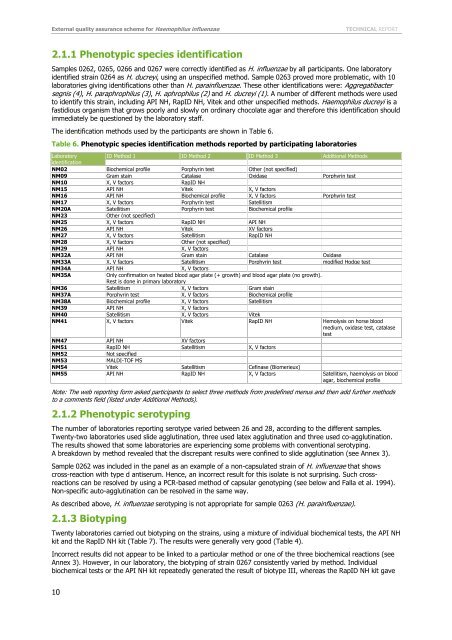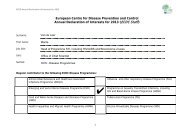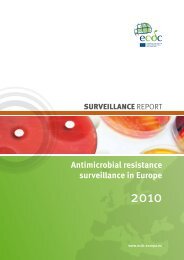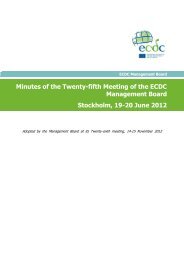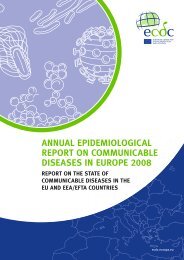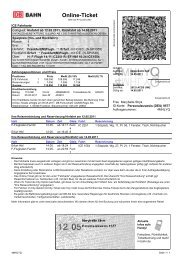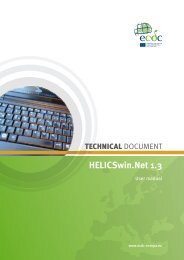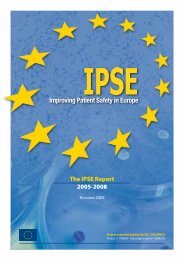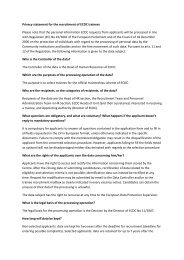External quality assurance scheme for Haemophilus influenzae 2011
External quality assurance scheme for Haemophilus influenzae 2011
External quality assurance scheme for Haemophilus influenzae 2011
You also want an ePaper? Increase the reach of your titles
YUMPU automatically turns print PDFs into web optimized ePapers that Google loves.
<strong>External</strong> <strong>quality</strong> <strong>assurance</strong> <strong>scheme</strong> <strong>for</strong> <strong>Haemophilus</strong> <strong>influenzae</strong><br />
TECHNICAL REPORT<br />
2.1.1 Phenotypic species identification<br />
Samples 0262, 0265, 0266 and 0267 were correctly identified as H. <strong>influenzae</strong> by all participants. One laboratory<br />
identified strain 0264 as H. ducreyi, using an unspecified method. Sample 0263 proved more problematic, with 10<br />
laboratories giving identifications other than H. para<strong>influenzae</strong>. These other identifications were: Aggregatibacter<br />
segnis (4), H. paraphrophilus (3), H. aphrophilus (2) and H. ducreyi (1). A number of different methods were used<br />
to identify this strain, including API NH, RapID NH, Vitek and other unspecified methods. <strong>Haemophilus</strong> ducreyi is a<br />
fastidious organism that grows poorly and slowly on ordinary chocolate agar and there<strong>for</strong>e this identification should<br />
immediately be questioned by the laboratory staff.<br />
The identification methods used by the participants are shown in Table 6.<br />
Table 6. Phenotypic species identification methods reported by participating laboratories<br />
Laboratory<br />
ID Method 1 ID Method 2 ID Method 3 Additional Methods<br />
identification<br />
NM02 Biochemical profile Porphyrin test Other (not specified)<br />
NM09 Gram stain Catalase Oxidase Porphyrin test<br />
NM10 X, V factors RapID NH<br />
NM15 API NH Vitek X, V factors<br />
NM16 API NH Biochemical profile X, V factors Porphyrin test<br />
NM17 X, V factors Porphyrin test Satellitism<br />
NM20A Satellitism Porphyrin test Biochemical profile<br />
NM23<br />
Other (not specified)<br />
NM25 X, V factors RapID NH API NH<br />
NM26 API NH Vitek XV factors<br />
NM27 X, V factors Satellitism RapID NH<br />
NM28 X, V factors Other (not specified)<br />
NM29 API NH X, V factors<br />
NM32A API NH Gram stain Catalase Oxidase<br />
NM33A X, V factors Satellitism Porphyrin test modified Hodge test<br />
NM34A API NH X, V factors<br />
NM35A<br />
Only confirmation on heated blood agar plate (+ growth) and blood agar plate (no growth).<br />
Rest is done in primary laboratory<br />
NM36 Satellitism X, V factors Gram stain<br />
NM37A Porphyrin test X, V factors Biochemical profile<br />
NM38A Biochemical profile X, V factors Satellitism<br />
NM39 API NH X, V factors<br />
NM40 Satellitism X, V factors Vitek<br />
NM41 X, V factors Vitek RapID NH Hemolysis on horse blood<br />
medium, oxidase test, catalase<br />
test<br />
NM47 API NH XV factors<br />
NM51 RapID NH Satellitism X, V factors<br />
NM52<br />
Not specified<br />
NM53<br />
MALDI-TOF MS<br />
NM54 Vitek Satellitism Cefinase (Biomerieux)<br />
NM55 API NH RapID NH X, V factors Satellitism, haemolysis on blood<br />
agar, biochemical profile<br />
Note: The web reporting <strong>for</strong>m asked participants to select three methods from predefined menus and then add further methods<br />
to a comments field (listed under Additional Methods).<br />
2.1.2 Phenotypic serotyping<br />
The number of laboratories reporting serotype varied between 26 and 28, according to the different samples.<br />
Twenty-two laboratories used slide agglutination, three used latex agglutination and three used co-agglutination.<br />
The results showed that some laboratories are experiencing some problems with conventional serotyping.<br />
A breakdown by method revealed that the discrepant results were confined to slide agglutination (see Annex 3).<br />
Sample 0262 was included in the panel as an example of a non-capsulated strain of H. <strong>influenzae</strong> that shows<br />
cross-reaction with type d antiserum. Hence, an incorrect result <strong>for</strong> this isolate is not surprising. Such crossreactions<br />
can be resolved by using a PCR-based method of capsular genotyping (see below and Falla et al. 1994).<br />
Non-specific auto-agglutination can be resolved in the same way.<br />
As described above, H. <strong>influenzae</strong> serotyping is not appropriate <strong>for</strong> sample 0263 (H. para<strong>influenzae</strong>).<br />
2.1.3 Biotyping<br />
Twenty laboratories carried out biotyping on the strains, using a mixture of individual biochemical tests, the API NH<br />
kit and the RapID NH kit (Table 7). The results were generally very good (Table 4).<br />
Incorrect results did not appear to be linked to a particular method or one of the three biochemical reactions (see<br />
Annex 3). However, in our laboratory, the biotyping of strain 0267 consistently varied by method. Individual<br />
biochemical tests or the API NH kit repeatedly generated the result of biotype III, whereas the RapID NH kit gave<br />
10


